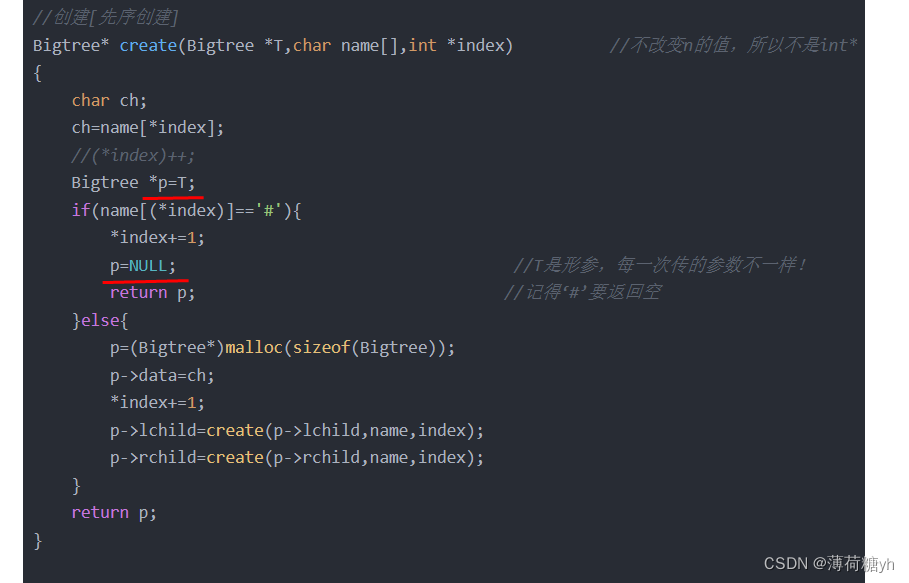二叉树的创建与遍历

{用先序讲解举例,请自己联系中序和后序(在最后):}
(在自己作为儿子的同时自己也是根)
注意:递归的形参不是你看到的形参,而是逻辑上的形参!
首先是创建的函数,如果我们要先序输入这样一个二叉树:那么我们在计算机内部其实是要先序输入:ab##c##的,【这里的‘#’用来表示没有数值了,把传入的形参置空NULL】

所以create创造函数里面的if-else语句第一次走else建立根结点,然后进入T->lchild
( p->lchild=create(p->lchild,name,index); ),递归这个函数,左儿子判断为b,所以进入else,又递归( p->lchild=create(p->lchild,name,index); )语句,判断为‘#’,进入if,说明这次的结点应该是空的,return NULL; 回到递归上一级的地方执行( p->rchild=create(p->rchild,name,index); ),这个函数的递归上一级是b的rchild,所以把b->rchild置空,回到再再上一级,也就是a的那一层,进入a->rchild...
以上是创建,遍历的时候,因为之前的函数是把地址置空,所以,在遍历函数中if的判断也是对当前形参的地址进行操作的。

/*二叉树的实现【创建与遍历】*/
#include<stdio.h>
#include<stdlib.h>
typedef struct Bigtree{char data;struct Bigtree *lchild;struct Bigtree *rchild;
}Bigtree;Bigtree* create(Bigtree *T,char name[],int *index);
void preoder(Bigtree *T);int main(){Bigtree *T;char name[50]={"ab##c##"};int index=0;T=create(T,name,&index); printf("\\n先序遍历为:"); preoder(T);return 0;
} //创建[先序创建]
Bigtree* create(Bigtree *T,char name[],int *index) //不改变n的值,所以不是int* n
{char ch; ch=name[*index];//(*index)++;Bigtree *p=T; if(name[(*index)]=='#'){ *index+=1; p=NULL; //T是形参,每一次传的参数不一样! return p; //记得‘#’要返回空 }else{p=(Bigtree*)malloc(sizeof(Bigtree));p->data=ch;*index+=1;p->lchild=create(p->lchild,name,index);p->rchild=create(p->rchild,name,index);}return p;
}//先序遍历
int i=0;
void preoder(Bigtree *T)
{//printf("\\norderT,[%d]==%p",++i,T);if(T==NULL){return;}else{printf("%c ",T->data);preoder(T->lchild);preoder(T->rchild);}} -------------------------------分割线------------------------
中序与后序遍历的代码:
//中序遍历
void inoder(Bigtree *T)
{if(T==NULL){return;}else{preoder(T->lchild);printf("%c ",T->data);preoder(T->rchild);}} //后序遍历
void underoder(Bigtree *T)
{if(T==NULL){return;}else{preoder(T->lchild);preoder(T->rchild);printf("%c ",T->data);}}


